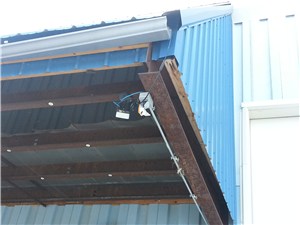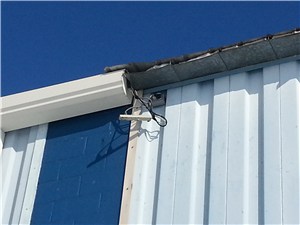Roof Heat Cables and Ground Fault Protection
It is important for all roof and gutter heat cable systems to be ground fault protected. This is whether the cables are exposed as in the typical zig zag roof heat cables commonly seen or they are embedded in roof and gutter ice dam prevention systems such as the IceBlaster Edge Melt System. Ground fault protection allows the circuit to turn itself off when there is a problem with the cable that would normally cause electrocution. It could be the result of damage from falling branches, animal damage, vandalism, abrasion on sharp surfaces (there are plenty in the gutter), and other types of physical damage. Without ground fault protection current could be allowed to energize anything the heat cable is in contact with causing serious injury or death. With ground fault protection the circuit will safely shut itself off when a ground fault is sensed. Common forms of ground fault protection are outlets with gfci, circuit breakers with gfci, and even thermostat controllers with equipment ground fault protection built in.
What type of ground fault protection should be used with heat cable systems?
If you are a DIY consumer, the standard outlet is what you would use with the typical plug in heat coils found at hardware and big box stores. These inexpensive heat tapes can be plugged into an outlet with gfci - these outlets have the test and reset button on them. If there is no gfci built into the outlet you have, please consider an adapter plug that has gfci built in to protect the heat cable. While these zig zag roof and gutter heat tapes have a relatively short lifespan and are limited in their effectiveness, many homeowners turn to them as a means to solve ice dam and icicle problems.
Professionally installed heat cable systems are usually hardwired. I say "usually" because every so often I run across a "professional" installation done by an electrical contractor that leaves me speachless. The picture to the right shows a heat cable installation on a commercial building in Oconomowoc, Wisconsin with a plug in outlet. Where do I begin with the code violations. Outdoor boxes need to have a 'bubble' cover so that when something is plugged in they can be fully closed. This outlet is also without ground fault protection. "It is probably ground fault protected at the circuit panel" you might state. I checked there, too. Nothing. regular breaker. This was a dangerous situation with gutters being damaged by cascading snow posing a serious possibility of damaging the cable and electrifying the surrounding area. Not to mention, this "professional" installation used a hardware store style heat tape to try to prevent the ice dams in this gutter. Not very successful.
"professional" installation done by an electrical contractor that leaves me speachless. The picture to the right shows a heat cable installation on a commercial building in Oconomowoc, Wisconsin with a plug in outlet. Where do I begin with the code violations. Outdoor boxes need to have a 'bubble' cover so that when something is plugged in they can be fully closed. This outlet is also without ground fault protection. "It is probably ground fault protected at the circuit panel" you might state. I checked there, too. Nothing. regular breaker. This was a dangerous situation with gutters being damaged by cascading snow posing a serious possibility of damaging the cable and electrifying the surrounding area. Not to mention, this "professional" installation used a hardware store style heat tape to try to prevent the ice dams in this gutter. Not very successful.
Indoor surge protector outlet strip used to plug heat cables into!
The problems for this commercial business in Oconomowoc, Wisconsin got worse when I inspected the other side. The facility manager indicated  the heat tape was not functioning and the ice dams were causing leaking into office areas. I looked over the installation and noted an inferior self regulating heat cable was used. I suspected it had failed prematurely. I wanted to check the power supply first before testing the cable. That is when I saw it - I could not believe my eyes. The picture to the left shows two sets of heat cables plugged into and indoor surge protector outlet strip. Another "professional" installation.
the heat tape was not functioning and the ice dams were causing leaking into office areas. I looked over the installation and noted an inferior self regulating heat cable was used. I suspected it had failed prematurely. I wanted to check the power supply first before testing the cable. That is when I saw it - I could not believe my eyes. The picture to the left shows two sets of heat cables plugged into and indoor surge protector outlet strip. Another "professional" installation.
While we may occasionally use an outdoor gfci outlet to plug in a small system, it is a good idea to hardwire into an outdoor junction box. Outdoor gfci outlets can be touchy - prone to nuissance tripping. Reseting is difficult if the outlet is placed up in the soffit area. If the outlet nuissance trips while the homeowner is on vacation, the ice dams may form before it is noticed and corrected. When hardwiring, a equipment ground fault protection circuit breaker should be used. This breaker is required by most heat cable manufacturers and will prevent nuissance tripping. I have seen hardwire heat cable installations done by professional electricians where gfci breakers were not used - extremely dangerous. I have also seen installations where residential gfci breakers were used contrary to what is required by the manufacturers. Be aware of these practices, choose wisely.
Is there "fault protection" for the consumer?
How do you protect yourself from the less than scrupulous or uneducated contractors? Take advantage of the information on this website and in the blog. There is a wealth of information here to assist you. When selecting a contractor, ask questions, make notes, make sure any estimate your get is written and descriptive. Make sure the materials you are quoted are what your receive. There are several ice dam prevention "specialists" in Wisconsin who advertise one heat panel system and install another. Don't forget to include Wisconsin Ice Dam Solutions in your bidding process.
